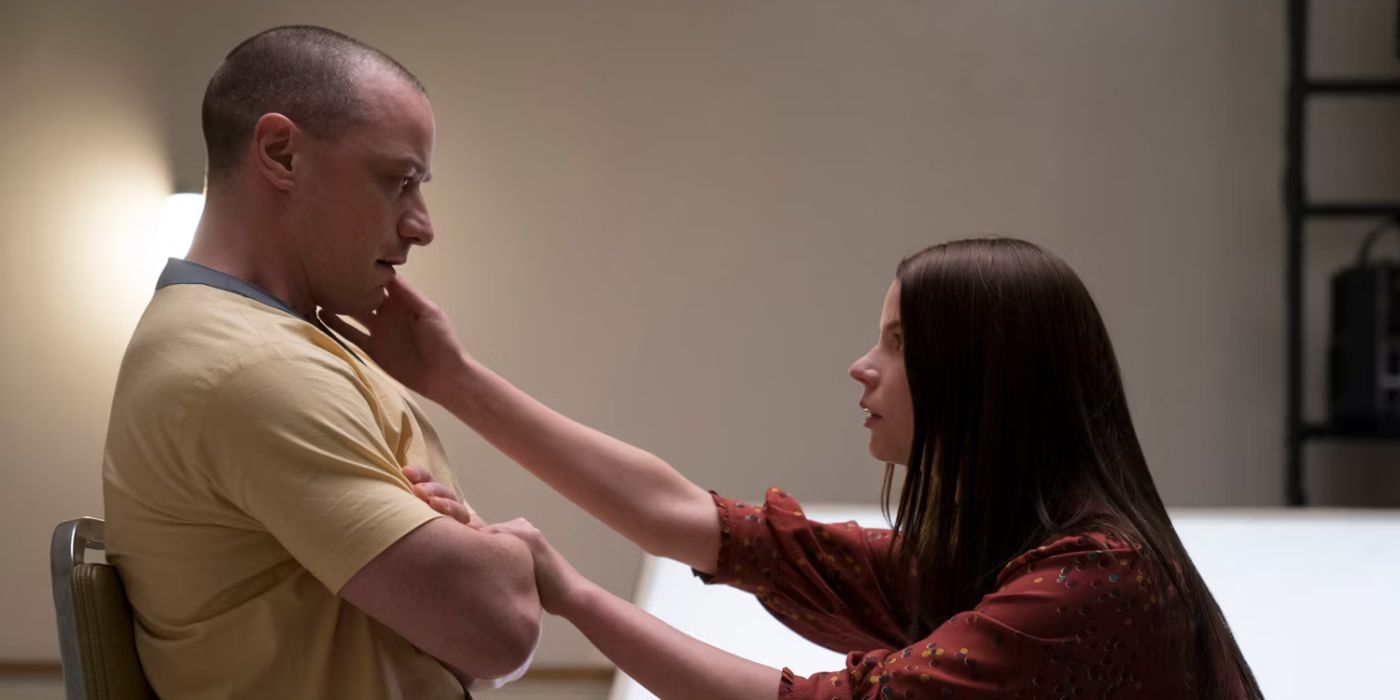The Big Picture
- M. Night Shyamalan’s
Split
drew inspiration from the real life court case of Billy Milligan. - Milligan’s landmark verdict of not guilty based on Dissociative Identity Disorder still captures public interest today.
- Shyamalan’s portrayal of DID in Split is based on Milligan’s case but takes many creative liberties.
While M. Night Shyamalan’s monstrous and supernatural representation of Dissociative Identity Disorder (DID) in his second installment of the Unbreakable trilogy, Split, is a point of controversy, when you look at the real-life court trial that inspired his character and the story, his decisions make more sense. Following the kidnapping of three teenage girls, Split explores DID through the unsettling character of Kevin Wendell Crumb (James McAvoy) up until the genre-bending finale. Parallels between details in Kevin’s character and the court case of Billy Milligan are confirmed by Shyamalan, who had been inspired by a novel, The Minds of Billy Milligan, ever since the ’90s.
Milligan committed horrific crimes of robbery, kidnapping, and rape and was released as innocent by the justice system of the late ’80s. He is the first person to use insanity on the basis of DID as a defense, and the first person to receive the verdict of not guilty because of it. While in today’s world, it is much more difficult to be acquitted based on mental health issues, the premise of this court case still captures the public eye to this day. Split is one of many media that draws inspiration from the case of Milligan. However, it is not by any means a retelling of the true events, but rather a fictional tale that contains remnants of the real case and is brought to life by McAvoy’s vast acting range and Shyamalan’s idiosyncratic twist-filled style.

Split
Three girls are kidnapped by a man with a diagnosed 23 distinct personalities. They must try to escape before the apparent emergence of a frightful new 24th.
- Release Date
- January 20, 2017
- Director
- M. Night Shyamalan
- Cast
- James McAvoy , Sebastian Arcelus , Ameerah Briggs , Betty Buckley , Izzie Coffey , Nakia Dillard
- Runtime
- 117 minutes
M. Night Shyamalan Has Always Been Inspired By DID
Shyamalan’s film features James McAvoy as Kevin, a man who is split by 23 alters, with a final 24th itching to be brought into the light. Split begins as a traditional kidnapping film, then delves into the scientific realm, and finally ends on a supernatural note. While maintaining the overarching psychological horror, Split’s most grounded exploration into DID occurs in the middle of the film, where the unique characteristics of the alters influence their personality and their physicality.
Although the outlandish ending is perceived as the exploitation of the negative stigma around DID, it turns out that Shyamalan has been intrigued by the condition ever since the ’90s. In a time when the majority of people didn’t believe it existed, Shyamalan was a firm believer in the disorder, further elaborating to The Straits Times that: “Those who have it constantly cover it up — they don’t want to be outed because they know you don’t see them as they are, so it’s super fascinating and poignant.” He was particularly interested in the physical effects of DID where one alter could have diabetes and required insulin shots yet another could be perfectly healthy, an idea that was translated to the film via the individual health conditions of each of Kevin’s alters.
Ever since learning Titanic director James Cameron was planning to film an adaptation of The Minds of Billy Milligan, which didn’t pan out, Shyamalan promised himself that he would make the movie someday. According to The Strait Times, he began writing the script in 2001 but would not produce the film until 15 years later. With years of meticulous research, refinement and carefully considered casting choices, Shyamalan finally released his dream project in 2016 while, of course, adding his own unorthodox flair.
What Were the Real Events That Inspired ‘Split?’
The character of Kevin is fictional, but his creation was inspired by a very real person who created a milestone in the courtroom by achieving the verdict of not guilty because of DID. Milligan was initially arrested in 1977 for multiple counts of robbery, kidnapping and rape of three women. However, during a psychiatric evaluation, he revealed he had DID, and it was one of his 24 alters that had committed the crimes. After one year, he went through rigorous evaluations by 9 different mental health professionals, including the notorious Cornelia Wilbur who wrote a novel, Sybil, that chronicled the life of someone with DID who later confessed they had made it up. In 1978, Milligan was acquitted of his crimes and institutionalized in a psychiatric hospital.
There were many factors that contributed to Milligan’s diagnosis, from witness statements to his history with trauma. Police officers who had interacted with him would note that it felt as if he would sometimes “shift personalities” and behavioral witness accounts often pointed towards discrepancies in his personality, where one victim claimed Milligan was soft-spoken while another said he had a rough accent. Moreover, Milligan had a history of alleged sexual abuse from his step-father, who always denied this, and had been hospitalized in a psychiatric facility when he was younger. He was diagnosed with what was termed “hysterical neurosis” that involved many dissociative symptoms that aligned with DID.
After 8 years of hospitalization, Milligan escaped from Central Ohio Psychiatric Hospital but was brought back within a year. Yet not long after, in 1988, he was deemed as not a danger to society and was released. Milligan died in 2014 of cancer at the age of 59. Throughout all those years, the media highly publicized the case, particularly The Columbus Monthly, The New York Times, and The Los Angeles Times. To this day, Milligan remains in the public space through documentaries, novels, films, and TV shows.
Would Billy Milligan Be Found Innocent Today?
While Milligan’s court case was the first of its kind, forensic psychologist Johnston believes that it hasn’t set a precedent for future attempts to use DID as a defense in the courtroom. She explains that the “insanity route” is generally much more difficult to take in the modern day as there is now a distinction between mental health and character. Attorneys and psychiatric evaluators now have to prove a direct link between the perpetrator’s mental health and their actions. There must be evidence that their actions are because of the symptoms of their mental condition, otherwise, it is simply a case of “this person has committed a violent crime, and they have mental illness.” This happened in the cases of Tom Bonney, who shot his daughter 27 times and tried using his DID as a defense but failed, or Kenneth Bianchi, dubbed the “Hillside Strangler,” who lied about having DID.
As such, while there is controversy around Shyamalan’s choice of source material, this bizarre case has firmly held the attention of the public eye for over 50 years now. Milligan’s case has appeared in the novel that inspired Shyamalan in the first place, the Netflix docuseries, Monsters Inside: The 24 Faces of Billy Milligan, and now The Crowded Room in 2023 where Tom Holland plays Milligan. Because it is unlikely to see a defendant plead not guilty in this manner these days, the case is continually being revived by the media. As such, the peculiarities of this milestone case seem to be standing the test of time.
How Accurate Is ‘Split’ to the True Story?
Details of Milligan’s case are directly reflected in the characterization of Kevin in Split, but Shyamalan clearly took some creative liberties with them. Both kidnapped three young women. However, Kevin never sexually assaulted them and instead killed two of the women, leaving Casey (Anya Taylor-Joy) the lone survivor. Through Casey’s own backstory about her abusive uncle, we learn that Kevin was also traumatized and haunted by his childhood just like Milligan. While the causes of DID is largely less understood or known, it is associated with being a coping mechanism in reaction to trauma. However, the most prominent similarity is that they both have 24 alters. This also comes with the biggest divergence from the Milligan case — while they both have violent alters, Kevin also has a secret one who possesses supernatural abilities.
While real details were used to adorn the narrative of Split, Shyamalan still had a tough casting call to make. As such, his choice of McAvoy completely sold the film. McAvoy’s gripping performance was a masterclass in versatility as he embodied characters of different ages, genders, and personalities and most importantly, he flits seamlessly between them. From the playfulness of young Hedwig, to the anguished Kevin, to the savagery of the Beast, McAvoy keeps us on our toes at every point of the film. While there is something to be said about the controversial final representation of DID in Shyamalan’s film, Milligan’s case continues to capture the public’s imagination today.
Split is available to stream now on Netflix in the U.S.


